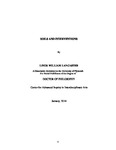Soils and Interventions
| dc.contributor.supervisor | Ascott, Roy | |
| dc.contributor.author | Lancaster, Linus | |
| dc.contributor.other | School of Geography, Earth and Environmental Sciences | en_US |
| dc.date.accessioned | 2016-05-27T11:06:31Z | |
| dc.date.available | 2016-05-27T11:06:31Z | |
| dc.date.issued | 2015 | |
| dc.identifier | 10280633 | en_US |
| dc.identifier.uri | http://hdl.handle.net/10026.1/4761 | |
| dc.description.abstract |
Linus Lancaster Soils and Interventions Dissertation Abstract The problem that I have identified during my research for this dissertation is the quantifiable depletion and exhaustion of large percentages of the world's soils through human activity in agriculture and other industrial practices. In the course of researching this problem I have looked closely at some of the primary causes, and a range of proposed and applied solutions in the field of ecology. The primary focus of the research has been in looking at how artists have responded to ecological issues and have engaged in environmental activism in their practices. Integral to the research has been direct participation in collaborative art practices that investigate and strive to raise public awareness about issues related to soil ecology. It has proceeded through reading established texts, interviewing expert practitioners, publishing my findings, and presenting at numerous conferences, concurrently with direct participation in ecologically oriented practices, related artistic projects, professional art exhibits, activist events, and working in the field of professional organic farming. During the research phase I attended nine Planetary Collegium Sessions with fellow researchers and received valuable direction from supervising professors. The result is a written, theoretical dissertation that documents the research through text and photography in seven chapters. It has also produced a body of sculptures and documented physical experiments and performances that are motivated by, and speak directly to issues of soil ecology. The efficacy of the artwork that has been made in the course of researching problems in soil ecology comes from its continuation of, and direct participation in, established, contemporary art projects and movements that have had a demonstrable influence of society. The contribution that it makes to new knowledge is by addressing in unique ways the emerging subject of soils, which have tended to be overlooked in many ecological discussions, and in so doing it also brings to bear a unique combination of influences in its practice. These include: Art practice, Situationist performances, Core Shamanic practice (as developed by Michael Harner), soil science, inspiration drawn from a number of continental theorists, participation in sustainable agriculture, and political activism, applied simultaneously in a transdisciplinary body of work described herein specifically on behalf of soils. In this endeavor the dissertation and its body of produced objects and performances has also sought to blur some of the conventional lines between theoretical research, contemplation and practice, as appropriate to a trans-disciplinary project. Numerous discoveries have been made in the course of the research, chief among them that the new transdisciplinary approach to soil studies that my collaborators and I have taken turns out to be of necessity if we are to avert large-scale collapses of agriculture due to soil degradation on a global scale in the course of this century. | en_US |
| dc.language.iso | en | en_US |
| dc.publisher | Plymouth University | en_US |
| dc.subject | Art Practice | en_US |
| dc.subject | Soil Ecology | |
| dc.subject | Environmental Activism | |
| dc.subject | Liminalities | |
| dc.title | Soils and Interventions | en_US |
| dc.type | Thesis | |
| plymouth.version | Full version | en_US |
| dc.identifier.doi | http://dx.doi.org/10.24382/3729 | |
| dc.identifier.doi | http://dx.doi.org/10.24382/3729 |
Files in this item
This item appears in the following Collection(s)
-
01 Research Theses Main Collection
Research Theses Main


